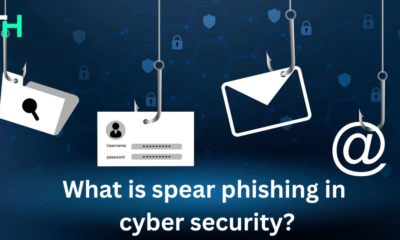Cybersecurity
SFTP Uses Which Mechanism to Provide Security for Authentication and Data Transfer?

Introduction: Why SFTP Security Matters More Than Ever
Imagine you are sharing your most private document across the internet. Would you leave it unsecured for anyone to read? Absolutely not! Just like physical documents need secure envelopes, digital data transfers require robust protection. When it comes to securely transferring files, SFTP (Secure File Transfer Protocol) is a go-to solution.
In this plain guide, we’ll dive deeply into:
- SFTP uses which mechanism to provide security for authentication and data transfer?
- Data Encryption: The Key to Confidentiality
- Ensuring Data Integrity: Preventing Tampering
- Password Authentication: The Traditional Approach
- Public Key Authentication: A More Secure Alternative
- Best Practices for Robust SFTP Security
Let’s get started.
What Is SFTP and Why Is It Important?
SFTP: Secure File Transfer Protocol Explained
SFTP, short for Secure File Transfer Protocol, is a network protocol that provides secure file access, file transfer, and file management functionalities over a reliable data stream. Unlike its old version, FTP (File Transfer Protocol), which transmits data in plain text, SFTP is built on top of the Secure Shell (SSH) protocol. This fundamental difference is what imbues SFTP with its inherent security capabilities.
The Critical Need for Security in File Transfers
In the digital era, data is the lifeblood of every individual and organization. Whether sensitive customer information, crucial business documents, or critical system files, the need to ensure its confidentiality, integrity, and availability during transfer is the priority. However, insecure file transfer methods leave data open for criminals to easily conduct cyber attacks, including spying, data tampering, and unauthorized access.
Key Benefits of SFTP:
- Encrypted file transmission.
- Robust user authentication.
- Resistance to common cyber threats.
- Ideal for remote file access and automation.
SFTP vs Other File Transfer Protocols
| Feature | FTP | FTPS | SFTP |
| Encryption | No encryption | Encrypted | Fully encrypted |
| Firewall Friendly | Not firewall friendly | Not firewall friendly | Easily passes through firewalls |
| SSH Integration | Not supported | Not supported | Fully integrated with SSH |
| Key-Based Authentication | Not supported | Not supported | Supports key-based authentication |
| Port | Uses multiple ports | Uses multiple ports | Uses a single port (Port 22) for all actions |
Hint: SFTP follows a better mechanism to provide security for authentication and data transfer Moreover, it’s more secure, easier to configure, and better suited for modern security needs.
Understanding SFTP uses which mechanism to provide security for authentication and data transfer?
The first line of defense in any secure system is authentication – verifying the identity of the users or systems trying to access it. SFTP employs several robust mechanisms to ensure that only authorized entities can connect.
Ensuring Identity: The Role of Authentication in SFTP
Before any data transfer can occur, the SFTP server needs to confirm that the client connecting to it is who they claim to be, and vice versa (though client authentication of the server is less common in standard SFTP usage but crucial for preventing man-in-the-middle attacks). This process, known as authentication, prevents unauthorized access and forms the basis of SFTP security.
Password Authentication: The Traditional Approach
The most common type of authentication in SFTP involves a username and password. When a client attempts to connect to an SFTP server, it is prompted to provide these credentials. The server then verifies these against its user database.
While simple to implement, password-based authentication has fundamental security weaknesses. Weak passkeys can be easily guessed through brute-force attacks. Furthermore, passwords can be intercepted if the underlying connection isn’t secure (which is precisely why SFTP’s use of SSH is vital).
Pro Tip: Must implement password authentication, and enforce strong password policies (length, complexity, regular changes). Set up account lockout rules to block access after several unsuccessful login attempts.
Public Key Authentication: A More Secure Alternative
Public key authentication, leveraging the power of asymmetric cryptography, offers a significantly more secure way to authenticate in SFTP. This approach requires the creation of two cryptographic keys—a public key and a private key.
- Public Key: This key is openly shared with the SFTP server and saved in the server’s authorized key file.
- Private Key: This key remains confidential and is securely stored on the client’s local system.
As the client tries to connect, the SFTP server issues a challenge directed at the client’s public key. The client’s software then uses the corresponding private key to generate a response that only the server can verify using the public key. This process proves the client’s identity without ever transmitting the private key over the network.
Host Key Verification: Ensuring You’re Talking to the Right Server
Host key verification ensures the client is connecting to the intended SFTP server and not a fraud (a crucial defense against man-in-the-middle attacks).
When a client connects to an SFTP server for the first time, it receives the server’s public host key. The client should then verify this key (often by comparing a fingerprint with a known good value obtained through a secure channel). On the following connections, the client compares the server’s presented host key with the one it has previously stored. If they don’t match, it indicates a potential security breach.
Multi-Factor Authentication (MFA): Strengthening an Extra Security Layer
For even greater security, SFTP can be integrated with Multi-Factor Authentication (MFA). This method asks users to verify their identity using two or more authentication factors before granting access.
For example, a user might need their SSH private key and a time-based one-time password (TOTP) generated by an authenticator app. Implementing MFA significantly reduces the risk of unauthorized access, even if one authentication factor is compromised.
Securing Data in Transit: Data Transfer Security Mechanisms
Once authentication is successful, the focus shifts to protecting the data as it travels between the client and the server. SFTP employs robust encryption mechanisms to ensure confidentiality and integrity.
Encryption: The Key to Data Privacy
The cornerstone of SFTP’s data transfer security is encryption, provided by the underlying SSH protocol. Encryption transforms data into an unreadable format (ciphertext) before it’s transmitted over the network. Only the intended recipient with the correct decryption key can convert it back to its original form (plaintext).
SFTP leverages strong encryption algorithms such as Advanced Encryption Standard (AES) with various key lengths (e.g., AES-128, AES-256) and other modern ciphers like ChaCha20. The specific encryption algorithms used are typically negotiated between the client and the server during the initial SSH handshake, with both sides agreeing on the strongest mutually supported cipher. Importantly, all data transferred via SFTP, including file content, commands, and even metadata, is encrypted, ensuring comprehensive protection.
Ensuring Data Integrity: Preventing Unwanted Modification
Beyond privacy, SFTP also ensures data integrity. This means that the data received is the same as the data that was sent, without any unauthorized modifications during transit. SSH achieves this through the use of cryptographic hash functions.
While transferring data, the sender generates a hash—a unique digital fingerprint—to represent the original content. The receiving side then recalculates the hash of the received data and compares it to the transmitted hash. If the hashes are identical, it verifies that the data remains intact and untampered with.
Secure Channel Establishment: The Role of SSH
All of SFTP’s security features – both authentication and data transfer protection – are provided by the Secure Shell (SSH) protocol. SSH establishes a secure, encrypted tunnel between the client and the server. This tunnel protects the entire communication session, ensuring that all data exchanged within it remains confidential and tamper-proof.
SFTP typically operates on TCP port 22, the standard port for SSH. Using a single, well-defined port simplifies firewall configurations compared to protocols like FTP, which use multiple ports and can be more challenging to secure.
Real-Life Applications of SFTP
Organizations from various industries trust SFTP for secure and reliable file transfers.
- Finance: Safeguarding critical financial data from unauthorized access.
- Healthcare: Ensuring HIPAA-compliant transmission of patient information.
- Legal: Safeguarding confidential case files during exchange.
These use cases highlight the versatility and reliability of SFTP in protecting critical data.
Best Practices for Robust SFTP Security
While SFTP inherently provides strong security, proper configuration and adherence to best practices are crucial to maximize its effectiveness.
- Strong Key Management: Implement secure processes for generating, storing, and rotating SSH keys. Protect private keys with strong passphrases and restrict access to them.
- Implementing the Principle of Least Privilege: Grant users only the necessary permissions on the SFTP server. Avoid using root or administrator accounts for regular file transfers.
- Regularly Updating and Patching SFTP Servers and Clients: Software updates often include critical security patches that address known vulnerabilities. Keeping your systems up-to-date is essential.
- Utilizing Firewalls and Network Segmentation: Configure firewalls to restrict access to the SFTP server to only authorized IP addresses or networks. Segmenting your network can further limit the impact of a potential security breach.
- Monitoring and Auditing SFTP Activity: Implement logging and monitoring mechanisms to track SFTP connections, file transfers, and any suspicious activity. Regularly review these logs for potential security incidents.
- Disabling Less Secure Protocols: Ensure that older, less secure protocols like plain FTP or Telnet are disabled on your servers to prevent accidental or intentional use.
How SFTP Mitigates Common Vulnerabilities
SFTP defends against:
- Man-in-the-Middle Attacks: Thanks to SSH’s encrypted tunnel and host key verification.
- Brute Force Attacks: Mitigated through key-based authentication and account lockout policies.
- Eavesdropping & Sniffing: Encrypted data ensures snoopers can’t read your information.
Frequently Asked Questions
Is SFTP encrypted by default?
Yes. SFTP always operates within an encrypted SSH session.
Can SFTP be used without SSH?
No. SFTP is inherently tied to the SSH protocol.
What port does SFTP use?
Port 22, the same as SSH—making firewall management easier.
Is SFTP better than FTPS?
Yes, in terms of simplicity, firewall compatibility, and key-based authentication.
Can you automate SFTP transfers securely?
Absolutely. Use secure tools like SFTP, SCP, or third-party libraries with key-based login and scheduled tasks.
Conclusion: Why SFTP is a Gold Standard for Secure File Transfers
SFTP doesn’t just move your data—it protects it every step of the way. With encryption, strong authentication, and integrity checks, it remains a trusted choice for secure file exchanges.
In summary, when you ask, “SFTP uses which mechanism to provide security for authentication and data transfer?”, the answer lies in the powerful combination of secure authentication methods provided by SSH (primarily password and public key authentication, along with host key verification and potential MFA) and robust data encryption and integrity checks also inherent in the SSH protocol. By leveraging these mechanisms, SFTP ensures that your sensitive data remains confidential and untampered with during its journey across networks. Embracing SFTP and implementing security best practices is not just a recommendation; it’s a necessity in today’s security-conscious digital world.
Note: To me, perceiving the security mechanisms behind SFTP is essential in today’s digital world — Moreover, if you’re interested in learning more about cybersecurity in general make sure to visit our website UniversalTechHub.com.
-

 Phishing attack5 months ago
Phishing attack5 months agoWhat is Spear Phishing and How You Can Identify This Scam?
-

 Social engineering attack7 months ago
Social engineering attack7 months agoBaiting Attacks Explained: A Closer Look at Cyber Threat Tactics
-

 Social engineering attack5 months ago
Social engineering attack5 months agoWhat are Social Engineering Attacks – A Complete Guide to Cyberattacks Prevention
-

 Social engineering attack7 months ago
Social engineering attack7 months agoSpear Phishing Attack: A Targeted Cyber Threat
-

 Social engineering attack7 months ago
Social engineering attack7 months agoWhat is spear phishing attack? A detailed guide
-

 Phishing attack5 months ago
Phishing attack5 months agoWhat Are Phishing Emails? A guide for you
-

 Social engineering attack7 months ago
Social engineering attack7 months agoWhat is spear phishing in cyber security?
-

 Phishing attack1 month ago
Phishing attack1 month agoWhy is Phishing Still a Major Cyber Threat? Everything You Need to Know




















